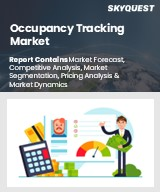
세계의 점유 추적 시장 규모는 2023년에 16억 달러로 평가되며, 2024년 20억 7,000만 달러에서 2032년에는 160억 5,000만 달러로 성장하며, 예측 기간(2025-2032년)의 CAGR은 29.2%로 성장할 전망입니다.
세계 점유 추적 시장은 건물 소유주들 사이에서 효과적인 공간 활용 모니터링과 지속가능성에 대한 요구가 증가함에 따라 꾸준히 성장하고 있습니다. 에너지 소비를 줄이기 위한 노력은 시장 성장을 더욱 촉진하고 있으며, 재실감지 센서는 이러한 감축을 달성하는 데 중요한 역할을 하고 있습니다. 시설 관리자와 건물 소유주는 점유 추적 시스템을 활용하여 안전성을 높이고, 공간 배분을 최적화하며, 에너지 효율을 개선하고 있습니다. 의료 환경에서 실시간 위치 추적은 자산관리에 큰 이점을 가져다주며, 환자 치료를 개선할 수 있습니다. 기술의 발전, 특히 패시브 적외선 센서, 초음파 센서 등의 센서 기능으로 인해 데이터의 정확도와 신뢰성이 향상되고 있습니다. 또한 무선통신 기술을 통해 설치가 간소화되어 다양한 환경에서 공간과 에너지 효율을 극대화할 수 있는 적응형 시스템을 구축할 수 있는 선택의 폭이 넓어졌습니다.
Global Occupancy Tracking Market size was valued at USD 1.6 billion in 2023 and is poised to grow from USD 2.07 billion in 2024 to USD 16.05 billion by 2032, growing at a CAGR of 29.2% during the forecast period (2025-2032).
The global occupancy tracking market is witnessing robust expansion, primarily fueled by the rising demand for effective space utilization monitoring and sustainability initiatives among building owners. Efforts to diminish energy consumption further propel market growth, as occupancy sensors play a critical role in achieving these reductions. Facility managers and building owners leverage occupancy tracking systems to enhance safety, optimize space allocation, and improve energy efficiency. In healthcare settings, real-time location tracking significantly benefits asset management and elevates patient care. Technological advancements, particularly in sensor capabilities like passive infrared and ultrasonic sensors, have enhanced data accuracy and reliability. Furthermore, wireless communication technologies simplify installation and broaden deployment options, enabling adaptable systems that maximize both space and energy efficiency across diverse environments.
Top-down and bottom-up approaches were used to estimate and validate the size of the Global Occupancy Tracking market and to estimate the size of various other dependent submarkets. The research methodology used to estimate the market size includes the following details: The key players in the market were identified through secondary research, and their market shares in the respective regions were determined through primary and secondary research. This entire procedure includes the study of the annual and financial reports of the top market players and extensive interviews for key insights from industry leaders such as CEOs, VPs, directors, and marketing executives. All percentage shares split, and breakdowns were determined using secondary sources and verified through Primary sources. All possible parameters that affect the markets covered in this research study have been accounted for, viewed in extensive detail, verified through primary research, and analyzed to get the final quantitative and qualitative data.
Global Occupancy Tracking Market Segments Analysis
Global Occupancy Tracking Market is segmented by Offering Type, Technology, Application, Deployment Type, End User and region. Based on Offering Type, the market is segmented into Hardware, Software and Services. Based on Technology, the market is segmented into Sensors, Image Recognition and Wi-Fi and Bluetooth Analytics. Based on Application, the market is segmented into Commercial Buildings, Residential Buildings and Indoor Navigation and Smart City Infrastructure. Based on Deployment Type, the market is segmented into On-Premises and Cloud-Based. Based on End User, the market is segmented into Facility Managers, Business Owners and Government Agencies and Academic Institutions. Based on region, the market is segmented into North America, Europe, Asia Pacific, Latin America and Middle East & Africa.
Driver of the Global Occupancy Tracking Market
A growing number of governments and organizations are actively seeking innovative ways to reduce carbon emissions and energy consumption. One effective approach is the implementation of occupancy tracking devices, which optimize energy use by automatically turning off lighting, heating, or cooling in unoccupied spaces. This technology not only enhances the overall efficiency of buildings but also leads to significant cost savings. As a result, many businesses are increasingly adopting these systems, recognizing their potential to contribute to sustainability goals while improving operational efficiency. This trend reflects a broader commitment to environmental responsibility and resource optimization.
Restraints in the Global Occupancy Tracking Market
A significant restraint in the Global Occupancy Tracking market is the growing concern regarding individual privacy. Many individuals fear that surveillance of their movements or occupancy patterns may infringe upon their personal privacy rights. Additionally, the reliance on systems that employ cameras or aggregate extensive data necessitates robust security measures to protect sensitive information. Such privacy issues can complicate the adoption and implementation of occupancy monitoring solutions, particularly in environments such as workplaces, educational institutions, and other public areas, where there is a heightened emphasis on safeguarding personal information and ensuring trust among users.
Market Trends of the Global Occupancy Tracking Market
The Global Occupancy Tracking market is experiencing significant growth driven by an increasing demand for smart building solutions. As more buildings integrate advanced technologies to enhance energy efficiency and occupant comfort, occupancy tracking systems are becoming essential for optimizing resource use. These systems enable intelligent management of lighting, heating, and cooling based on real-time occupancy data, significantly reducing operational costs and contributing to sustainability goals. This trend is particularly evident in commercial spaces, retail environments, and educational institutions, with both government initiatives and building owner investments fueling the adoption of smart upgrades to meet environmental regulations and improve operational efficiencies.